We are seeing whales like never before. Why?
By Richard Scott
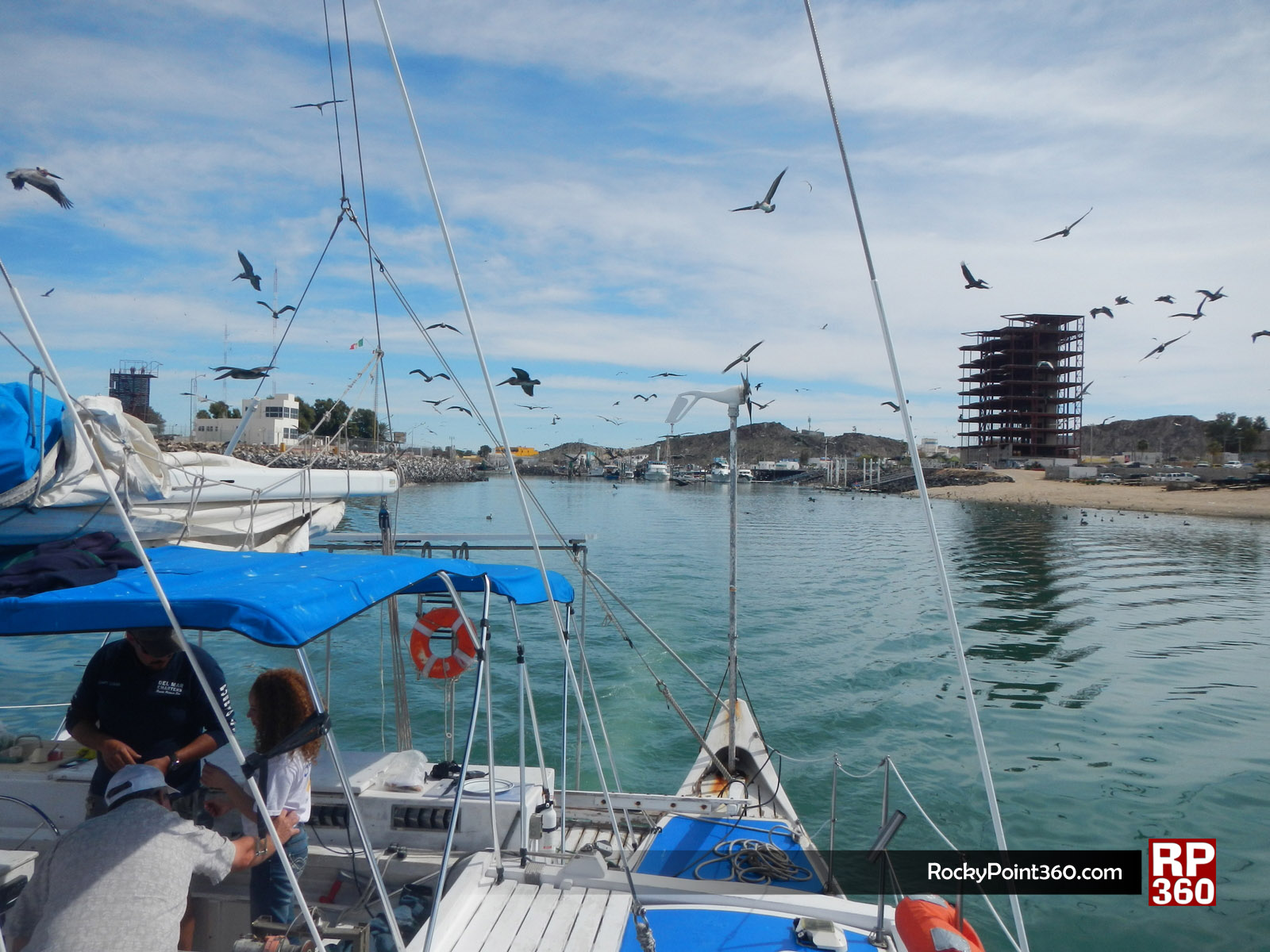
“Welcome aboard, we set sail in ten minutes.” Captain Oscar (of Del Mar Charters) idles the engines of the Tempo, while his assistant helps a group of Canadians onto the boat. “Fin Whales are awesome, massive. The second largest mammal on the planet. They’ve been here from the first of the year. February is the time to start looking for Humpbacks. What’s so spectacular about them is the breach, jumping out of the water and crashing back down.” “I want to see THAT” says three year old Lucy. “Aarrrgh, keep yur eyes open matey, ye may be da first to spot one. Aarrrgh” says the captain again, for full effect.
It is windless, the sea is smooth. Four boats go out today, helping each other find the whales. About ten minutes out of the harbor, our catamaran crosses paths with a pod of Bottleneck Dolphins. They decide to join us, swimming right in front, five and six at a time. The netting across the boat lets us lay down close to them. “Sweee”, there is a high pitched whistle. “Mommy, I heard the dolphin!” Lucy shouts.
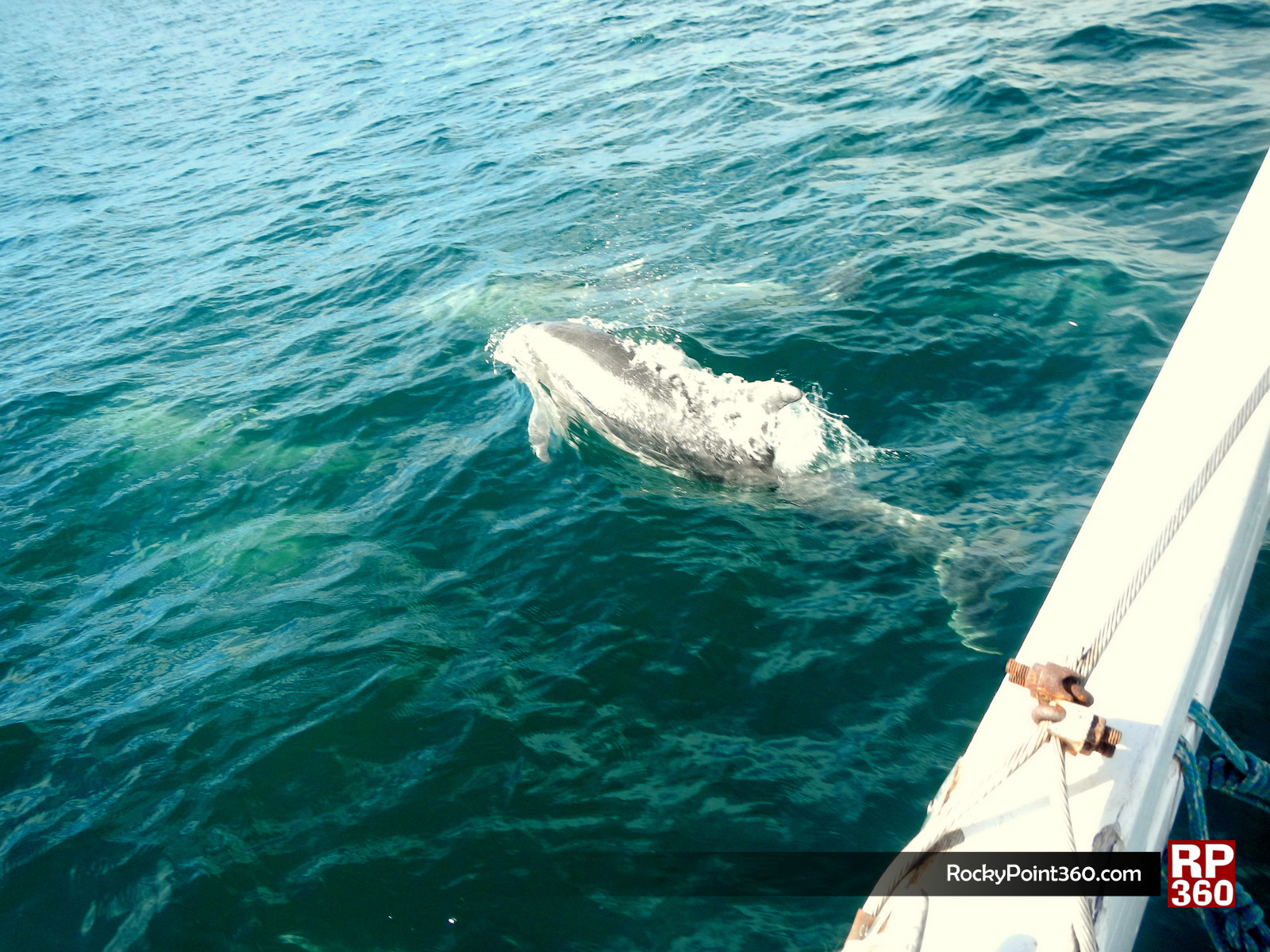
It’s not just whales and dolphins that are here in large numbers. Pelicans, Gulls, Cormorants, Terns and other birds are seen diving by the hundreds, head first into the Sea of Cortez. Real drama for the kayakers who paddle right up to the edge of the feeding frenzy. Underneath it all are the little fish. Millions of them. Is that what is attracting all the other sea life?
“There may be several reasons, including this year’s increased availability of food, but still we don’t know the reason for this sudden increase,” according to Paloma Valdivia, Coordinator for Education and Outreach at CEDO, the Intercultural Center for the Study of Deserts and Oceans located in Las Conchas.
“Last year we had lots of whales too, and now we see moms swimming with babies – the size difference is huge!” says Maru Zacatelco, President of Ecofun Rentals. “Whereever they are born they will come back to, that’s a fact. Just like sea turtles.”
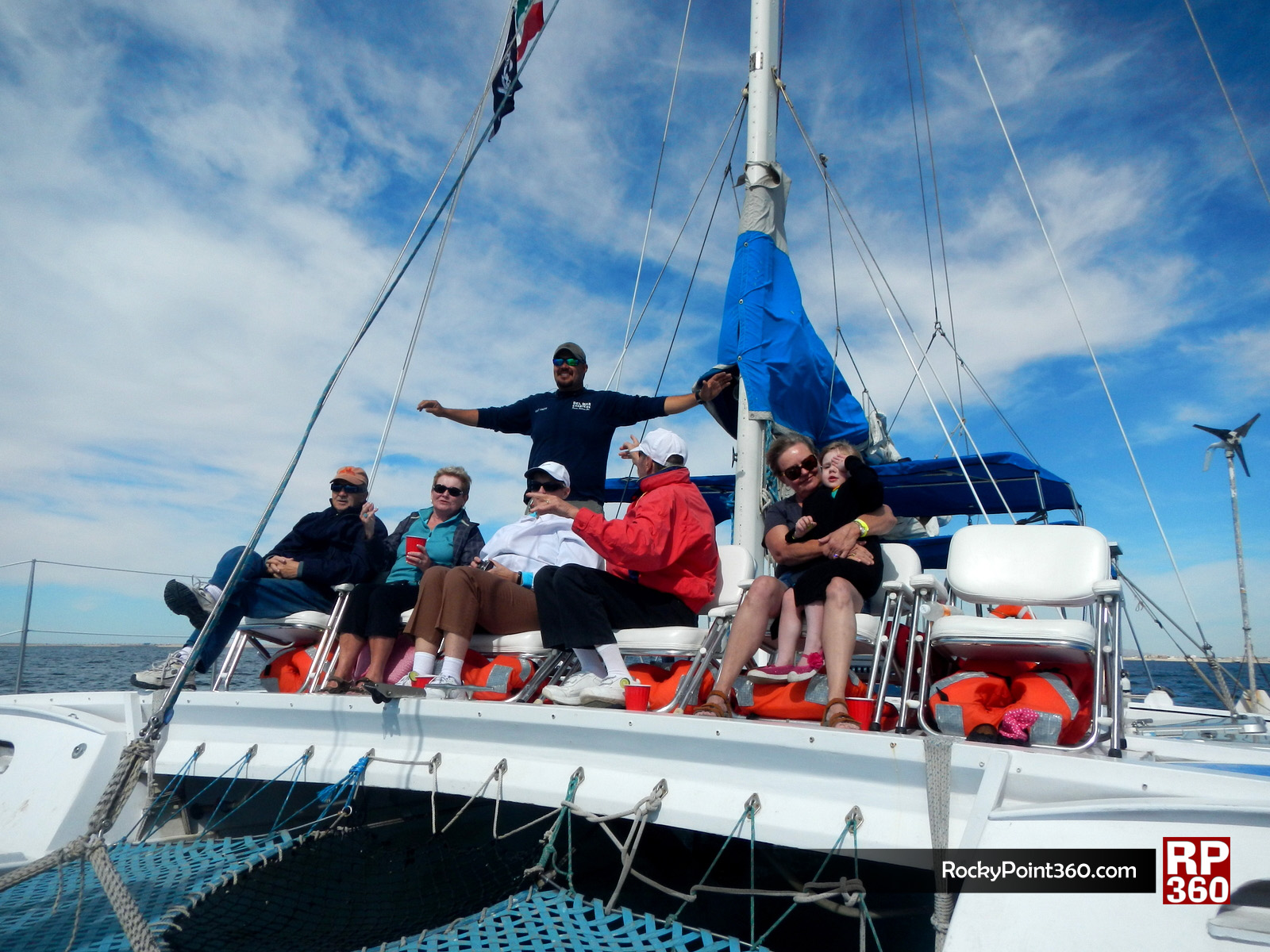
A crackling voice comes over the radio. The boats kill their engines. Maybe they saw a Fin, they say. All eyes on the Tempo stare, squinting at the spot Captain Oscar points to. Everyone is quiet, with only the occasional sound of ice cubes clinking when a Margarita is tipped back. “Sure beats the Hell out of Edmonton” says the man on my right, bringing whoops of laughter from his fellow Canadians. “It was minus twenty when I left” says another, “yeah, I can’t believe this is Febru…” “Woosh”. All of us look left. A cloud of mist rises from the blowhole on the back of our first Fin Whale. Then another. Side by side, two of the second largest mammals on the planet glide serenely by, their rounded backs a deep satin black.
The game is on. Each captain uses experience and intuition to move to the place where the whales will come up again. “Ooohhh” we hear from the passengers of the Gato Loco, the other sailing catamaran out today. There are two more Fin Whales right in front of them! This is how it goes for over an hour. Maybe eight whales total, not to mention more dolphins (Spinners this time) and a lone Sea Lion.
“Mind if we make the trip a little longer?” Asks the Captain. “I’ve got a lucky feeling.” “You can stay out here till Spring” someone replies. Watching two more Fins, something catches Oscar’s eye. “That tail, that means she’s heading down” he says. “Why’s she going down?” Asks Lucy. “Watch.” The two Fins slide silently as one, peaceful and at home.
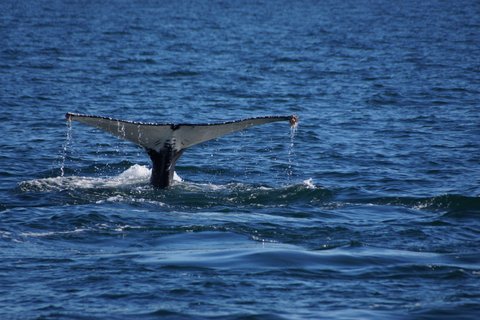
“Ooohhh look.” Coming straight out of the sea, first the head, then the white belly, the long dorsal fins, and finally that same tail. For a freeze-frame moment it seems to hover in the air, water shining on its blue skin. Momentum spent, the Humpback does an arching back flip. There is a sharp slap as she hits the water, it explodes into the sky, glaring so bright some have to turn away.
A round of applause breaks out from the assembled boats as the sea goes calm once again. “The Fins will start leaving soon, but the Humpys will be here through March” Oscar tells me. “What comes after the Humpbacks?” Asks Lucy. “Arrgh” says Captain Oscar, “that would be Spring Breakers.”
Avistamiento de ballenas en Puerto Peñasco – Como nunca
Por Richard Scott
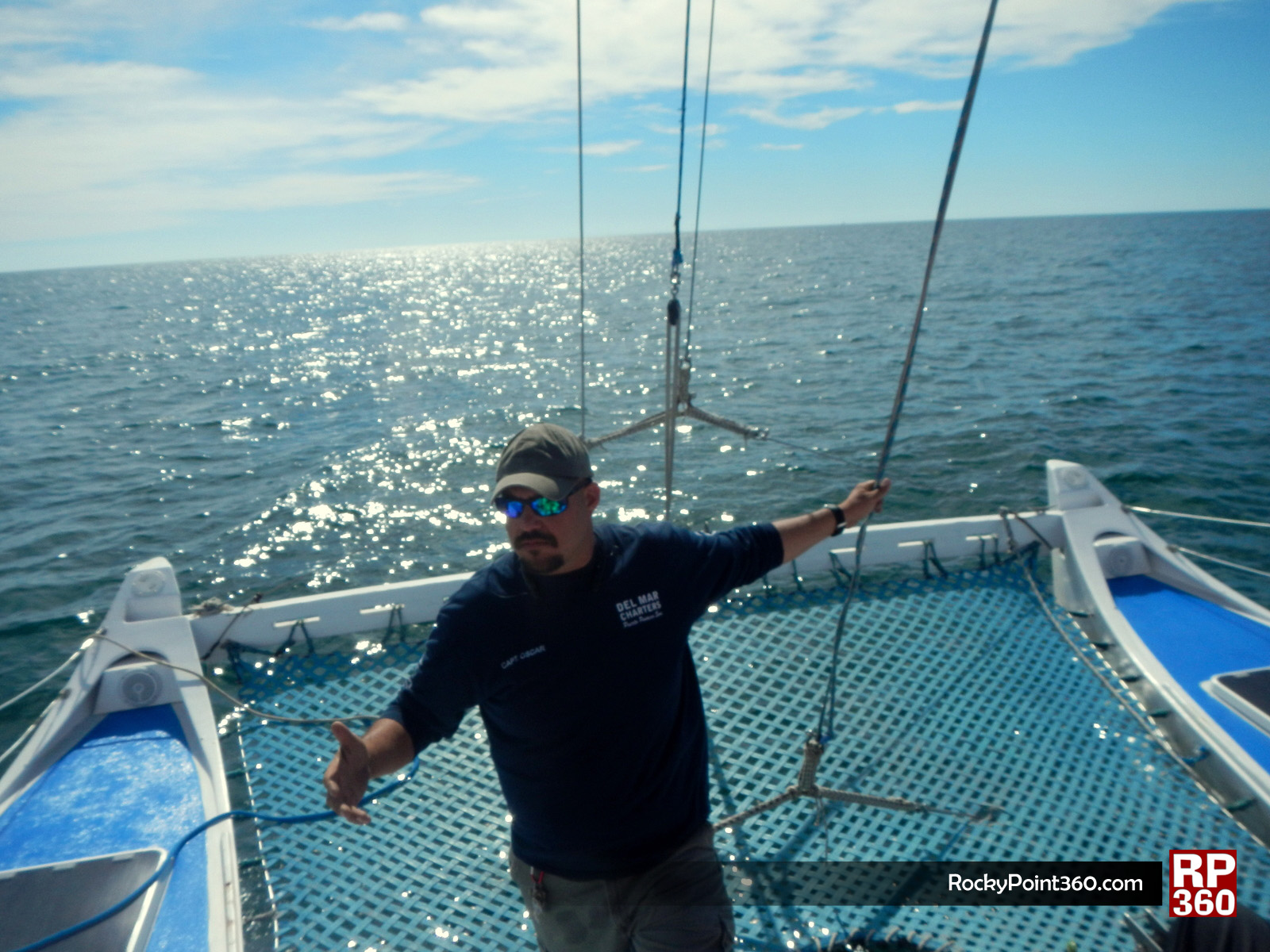
“Bienvenidos a bordo. Saldremos en unos diez minutos,” nos comenta Capitán Oscar mientras su asistente le ayuda a un grupo de canadienses subirse al catamarán. “Las ballenas aleta son increíbles y enormes; son los segundos mamíferos más grandes en el planeta y han estado por acá desde principios de año. Febrero ya es la época de empezar a buscar las ballenas jorobadas. Lo espectacular de ellas es cómo rompen el agua, brincando y luego cayendo.”
…
No solo son ballenas y delfines los que se encuentran aquí en mayor cantidad que antes, sino también pelícanos, gaviotas, cormoranes, charranes, y otros pájaros que se puede admirar entrando al agua a toda velocidad, muchas veces en grupos enormes. Debajo de todo son millones de peces, millones.
¿Es lo que está atrayendo tanta vida marina este año?
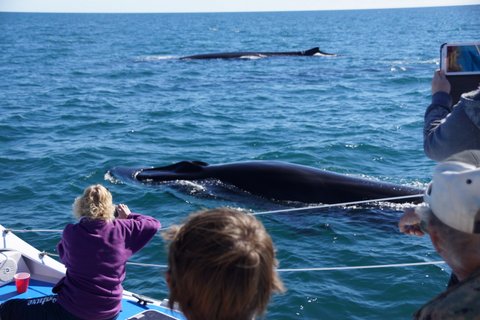
“Puede haber varias razones, incluyendo la gran disponibilidad de alimento este año, pero aun así todavía no sabemos la razón exacta,” comenta Paloma Valdivia, Coordinadora de Educación de CEDO (Centro Intercultural de Estudios de Desiertos y Océanos) en Las Conchas.
“El año pasado también tuvimos muchas ballenas, y ahora vemos a las mamás nadando con sus crías – la diferencia de tamaño es enorme,” dice Maru Zacatelco, Presidenta de la compañía de excursiones EcoFun. Zacatelco agrega, “Es un hecho que las ballenas regresan al lugar donde nacen, así como las tortugas del mar.”
…
¿No les molesta si alargamos un poquito más el viaje?” nos pregunta el capitán, “tengo una sensación de suerte.” “Nos podemos quedar hasta la primavera,” alguien grita desde atrás del catamarán.
Después de ver dos aletas de ballenas, hay algo que le llama la atención a Oscar. “La cola así, esto significa que va hacía a bajo,” nos explica. “¿Por qué?” una niña le pregunta. “Hay que esperar un poco…” le dice.
“Ooooh ¡Mira!” Saltando directamente del mar: primero aparece la cabeza, luego una panza blanca, sus aletas, y al final la misma cola. Por una milésima de segundo parece hasta que ésta vuela por encima del mar, con el agua brillando en su piel azul. Ya pasado el momento, la ballena jorobada voltea a su espalda antes de caerse nuevamente, generando reflejos de agua asombrosos.
Una ronda de aplausos surge de los barcos reunidos mientras el mar recupera su tranquilidad. “Las ballenas aletas pronto empezarán a retirarse, pero las jorobadas estarán hasta marzo,” me dice Oscar. “¿Y qué viene después de las jorobadas?” le pregunta nuevamente la niña. “Arrrr-” le contesta el capitán como buen pirata, “pues, serían los spring breakers.”